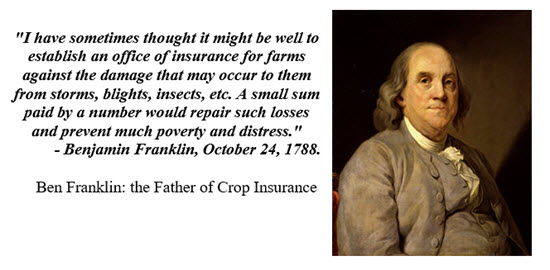Crop Insurance: Priority #1
 No
matter who wins this November’s presidential election, one of the first items
facing a new Secretary of Agriculture will be developing a 2018 Farm Bill, a
process sure to begin early in 2017. As we start that effort, its worth noting
that for all its rich diversity, American agriculture seems to be united behind
a few large overarching issues: coordinated and scientific regulatory policy by
EPA, FDA and USDA; healthy trade promotion; biotechnology; and, farm labor
issues, including immigration.
No
matter who wins this November’s presidential election, one of the first items
facing a new Secretary of Agriculture will be developing a 2018 Farm Bill, a
process sure to begin early in 2017. As we start that effort, its worth noting
that for all its rich diversity, American agriculture seems to be united behind
a few large overarching issues: coordinated and scientific regulatory policy by
EPA, FDA and USDA; healthy trade promotion; biotechnology; and, farm labor
issues, including immigration.
But
at the individual farmer level, no issue is more important than defending and
improving Federal crop insurance. All farm groups agree that crop insurance is
critical to the future of agriculture, leveling out the booms and busts.
Crop
insurance has deep roots in America. As noted above, Benjamin Franklin first
raised the idea back in the 1780’s as a way of applying good Yankee sense to
agriculture. The Federal program itself dates back almost 80 years to 1938.
Crop
insurance remained a small program limited mostly to Midwest row crops, though,
until the 1990’s when the disastrous 1993 flood prompted Washington leaders to
fundamentally re-think how best to respond to emergencies.
The
1993 flood had caused massive crop losses through wide swaths of the country
and forced Congress to respond by enacting an off-budget, after-the-fact, $8
billion ad hoc disaster relief
bail-out package, which was typical for that era. Farmers waited months for
relief, the process was plagued with uncertainly, and taxpayers suffered as
well. Beginning that year, a succession of Congresses and Administrations spanning
three decades and three Administrations, both Democratic and Republican, began
investing in Federal crop insurance as an alternative, increasing fiscal
supports and developing better products in partnership with private providers.
The
changes worked. Higher-quality crop insurance became affordable, and farmers
began voting with their checkbooks to make it a stable, permanent replacement
for the old ad hoc disaster bailouts. Today, farmers can insure everything
from yields to revenue and input costs, from corn to clams, cabbage and
cultivated wild rice.
Today’s
modern crop insurance system is a vast improvement over what existed just a few
decades ago. Sheer numbers tell much of the story. Federal crop insurance today
covers almost 300 million areas of American farmland, over 90 percent for major
commodities and over 70 percent for specialty crops, representing over $100 billion
in insurance guarantees. USDA backs the program by developing and regulating
the policies, subsidizing a portion of the farmers’ premiums, and providing
financial backup to the seventeen private companies approved to deliver the
program through its Standard Reinsurance Agreement.
Federal
crop insurance today covers more than a hundred individual crops representing
over 540 types and varieties. Coverage takes a multitude of forms: yield
protection, revenue protection, margin protection, whole farm policies,
livestock risk protection, rangeland coverage, special policies for organics,
and a growing list of tailored policies for smaller crops. While some regions
and crops remain underserved, this list grows shorter each year.
As
other federal farm support programs have been affected over the years by budget
cuts, adverse international trade rulings, and political crossfires, crop
insurance has grown into the indispensable element of the Federal safety net
for American farm producers.
One
key example of how American farmers have grown to rely on crop insurance came
last October when Congressional leaders quietly inserted a $3 billion crop
insurance spending cut into the two year budget agreement. The move sparked an
almost-unprecedented and immediate uprising from across the agricultural
community -- all regions, all crops, bipartisan – forcing the Congressional
leadership to agree to repeal the cut in the omnibus appropriations bill.
There
are good reasons for this growing acceptance:
- The crop
insurance model is flexible and highly adaptive. It can cover specialty
fruits and vegetables like apples and cherries as well as big row crops
like wheat, corn, and cotton, while insuring yield risk as well as price
risk, all under the same umbrella. Every year, new features are added and
built into an actuarial structure that protects the program’s fiscal integrity.
- It puts
individual farmers in the driver’s seat. Farmers pay a premium charge for
their insurance, giving them ownership and responsibility. They can then
tailor it to their operations and business plans, choosing their own
features and coverage levels and using their individual yield histories. Farmers
have seen how the system rewards good management and record-keeping, and
many have upgraded their own internal management systems accordingly. Also,
since crop insurance guarantees are based on annual legal contracts, no
politicians can step in and take them away once signed for the year.
- It uses a
unique private-public partnership combining the dynamism of private
enterprise with the stability of government oversight. Under it,
USDA-backed policies are delivered to farmers by seventeen private
insurance companies and some 15,000 private insurance agents who can
assure payment of claims within 30 days once a claim is finalized. And in
addition to USDA support, these companies also place significant portions
of their insurance risk with private reinsurance firms that spread the
risk around the globe -- another savings for taxpayers.
Marshall
Matz and Ken Ackerman are partners at OFW Law, specializing in agriculture. Mr.
Ackerman was the Manager of USDA’s Federal Crop Insurance Corporation from 1993
to 2001.
#30

